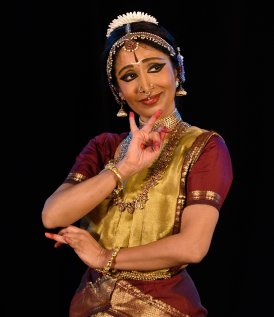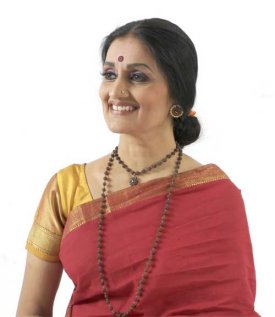
|  |

|  |
 Fitness for dancers - Ranee Kumar e-mail: Ranee@journalist.com February 6, 2016 By and large, when reviewing a dance performance, on principle, I make no mention of the age or physical appearance of a dancer as I see her on stage. Generally, this is a part of journalistic ethics; personally age factor has never appealed to my mind unless I find a tender artiste emoting a rather tough abhinaya with spontaneous ease. The second factor, the physical appearance, of course, this I curb myself from making a mention of it, more so when it is far from being complimentary to the artiste in question. But I must own up, that bloated figures on stage, young or old, are a disturbing sight to the audience, leave alone a critic. Not to stir a controversy, I would like to briefly explain that it is not mandatory that a dancer needs to have a gym-toned body. On the other hand, I don't quite agree that if one is an exquisite, excellent dancer, well her figure, no matter how uncouth, shouldn't worry us. Well, a weighty body is not light on the feet to that extent, and the nritta has to be scaled down. Then comes the TINA (there is no alternative) factor where you make do with matured, excellent abhinaya and minimal footwork or at times no footwork at all. This critic has been a witness to both and much more. Can a dance be complete without nritta complimenting abhinaya and vice-versa in a balance of both? I've chosen to interview two mature artistes whom I consider a pleasure to 'view' on the stage both in terms of their dance and figure. Why did I have to choose only these two? Definitely no favouritism intended. They are artistes who live by the 'art for art's sake' dictum with an underlying spirituality that is evident in their respective dance form. If the objective of an art form is firstly to appeal to connoisseurs (not necessarily conservatives), these two experienced dancers, Alarmel Valli and Mandakini Trivedi move their audience to shed tears of joy - the 'rasothpatthi' (rasa-uthpatthi) actually happens, not just in this critic but in a cross-section of intelligent audience. It makes you feel that there is more to it than mere experience and practice of dance. The background factors like personal habits and fitness regime must be contributing to their on-stage power to evoke emotion. There are a few others of this calibre too but I've left them unmentioned because they are in the younger bracket, age-wise. Both Valli and Mandakini have a few common features: they look upon dance, not just as an art form to be perfected and performed but as a spiritual quest in which the seeker finally identifies her 'self' with a higher 'self' through the medium of dance. So it goes without saying that the body is a receptacle for the dance which goes into a quest and expresses itself. Both respect our ancient Yoga as a means to stay mentally tuned to the body and vice-versa. Dance is the fulcrum of their life and all else is simplified to suit and enhance the divine art.  A look at Valli's food regimen, her flexibility and grace as she moves around is enviable to many a young artiste. "My diet is quite boring," she laughs away even as she settles down to recounting them diligently. "I can't say there's a hard and fast rule on diet as it varies from person to person. Though I was never a robust girl, with age now, I'm more careful. No greasy food stuff. I have a sweet tooth but I never binge. My breakfast is oats / flaxseed, tender coconut, glass or two of yogurt and boiled egg white. The lunch is usually phulkas (dry chapatti), cooked vegetable gravy, dhal and lots of spinach. Tea just one cup; coffee is more or less an occasional treat! The dinner like all south Indians is 'tiffin'- idli, dosa, at times pasta with a bowl of yogurt. On principle, I believe in being sensitive to my body. As we become seniors, our body metabolism is bound to change and the burning out in youth doesn't occur anymore. Hence a judicious diet!" On fitness as a dancer, Valli has a lot to offer. "At each stage of a dancer's life, I've realised that you have got to be sensitive to every little twinge that really speaks to you and treat your body accordingly. Wear and tear due to dancing can cause health hazards especially to neck, spine, knees and heels since these are pressure points. Actually the old dance technique is very body-friendly. My guru Subbaraya Pillai and Chokkalingam Pillai would insist on the use of the hollow of my feet and not the heels in executing footwork. This light and shade use of feet would ensure the tapping sound without harming your heel; it's like the touch on the mridangam. We should come out of this misconception that the louder you tap your feet the more excellent you are; on the other hand your feet should subtly play the nuances." On the best stamina for a dancer, Valli insists that is nothing than regular, consistent practice. "If I don't dance for a day whatever be the reason, all sorts of aches are bound to appear. This, now coupled with Yoga is my fitness regimen. Yoga is vital as it counterbalances the wear and tear. I can say with absolute conviction that there's no substitute to consistent practice of dance; it lends fluidity to the body, allows you to internalize and reach a level of identification with your idiom."  Taking off from the Yoga point, Mandakini Trivedi, a gracious and attractive dancer, lends her view with authentication from dance treatises of yore. "I believe a back-up sadhana in Yoga is a must for practitioners of classical Indian dance, not just asanas and breathing techniques but also higher Yogic practices of mantra and meditation. And as years go by, one can scale down dance practice and increase Yoga sadhana which lends maturity, subtlety and depth to one's dance. Dance is parallel Yoga but now it is not taught together, hence the back-up." Quoting Abhinaya Darpanam, she says, " The qualities of a dancer under 'patra lakshanam' and 'varjaniya patrani' (disqualification of a dancer) find a place in the great treatise and both these do include physical looks, not to say that it gets restricted to looks alone. Learning and abhyasa (knowledge and practice) endow intensity and sensitive appearance to a dancer. Mannequin perfection in looks is not at all mandatory." She opines that the body of a dancer has to be fit for dance. Often perfection in dance is marred because the dancer's body is not ready and trained for the task. The Natya Sastra charis are described as 'vyayama' and can be effective in toning the lower limbs. Personally I find hitting the gym as a sort of battling with inanimate machines and is not the best way to develop a 'sensitive' body. Our arts are introverted and best aligned to the practice of Yoga which focuses on health of the inner organs, purification of inner channels and disciplining of breath to attain subtle energy and sensitivity. Rigorous exercises work against this introversion. I think we follow Western trends without understanding their origin. The dance tradition there grew out of gymnastics in royal courts, while ours was nurtured in and around temple rituals and Yagna vedikas." Fitness and nutrition are the first steps on the ladder to dance and yet they are not addressed by most teachers. "My sadguru Swami Shri Harish Madhukar has bestowed me with higher Yoga and meditation that is like the mother of my other practices." Trained under Shri Sharad Pathak, Mandakini practices Yoga and Pilates for 24 minutes and on days when there is no time, a four-and-half minute warm up with a Surya namaskar. "I've learnt my adavus of nutrition from Dr. Vijaya Venkat, and I've learnt to choreograph my own customized routine within certain parameters. A major part of my diet includes fresh fruit, vegetables, salads, sprouts and nuts. An early dinner where cooked food is avoided is also something I try to follow at my age." Ranee Kumar, a journalist for the past two decades, has worked with mainstream newspapers from Hyderabad. She later took to freelancing for The Hindu in art and culture as their art critic. Ranee has many articles, reviews in music, dance and drama published to her credit. Response * Narthaki has always been a friend, philosopher and guide for Dance practitioners...Blessed to have narthaki.com - Gauri Pawgi (March 7, 2016) Post your comments Provide your name and email id along with your comment. All appropriate comments posted with name and email id in the blog will also be featured in the site. |